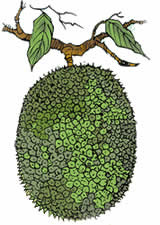
Dimdima
Online Children's Magazine from India

Dimdima
Online Children's Magazine from India

All fruits have a distinctive smell that helps advertise their presence to pollinators, but the durian tree takes this technique to extremes. Its ripe fruit can be smelled from half a kilometre away. Most strangers to the forest find the smell repulsive but locals find it invigorating and at once set out in search of the tree. They have to be quick because a large number of the forest’s denizens will also be following the smelly trail.
Orangutans, squirrels and hornbills collect the fruit while they are still hanging from the tree. Mouse deer, sun bears, and even tigers eat the fallen fruit. In season, the ground below the durian is littered with torn rinds and large numbers of black seeds that some animals have spat out during their meal.
From the tree’s point of view, these are the failures: they will germinate but will not grow to any great height as they are in the shade of the parent tree. The successes are those seeds that have been swallowed. These will remain undigested in the animal’s stomach and pass out in the normal manner, far away from the parent tree.
The durian is grown extensively in Southeast Asia especially in Thailand, Malaysia and Indonesia, in which countries it is regarded as the king of fruit. It is believed to have originated in Java and Sumatra, but today Thailand is the largest producer. Connoisseurs of the fruit say that Thai durians, especially the luscious Monthong variety are the best in the world, an opinion not shared by Malaysians who claim that their durians, though smaller, have a richer flavour. Durians have been introduced into northern Australia, Hawaii, some Caribbean countries and parts of southern India.
Last updated on :6/12/2006
EXPLORE MORE...
COMMENT ON THIS ARTICLE
Wants to share something related to this article? Please use the form below.
Dimdima is the Sanskrit word for ‘drumbeat’. In olden days, victory in battle was heralded by the beat of drums or any important news to be conveyed to the people used to be accompanied with drumbeats.
Bharatiya Vidya Bhavan
K. M Munshi Marg,
Chowpatty, Mumbai - 400 007
email : editor@dimdima.com
Bharatiya Vidya Bhavan
505, Sane Guruji Marg,
Tardeo, Mumbai - 400 034
email : promo@dimdima.com
Dimdima.com, the Children's Website of Bharatiya Vidya Bhavan launched in 2000 and came out with a Printed version of Dimdima Magazine in 2004. At present the Printed Version have more than 35,000 subscribers from India and Abroad.